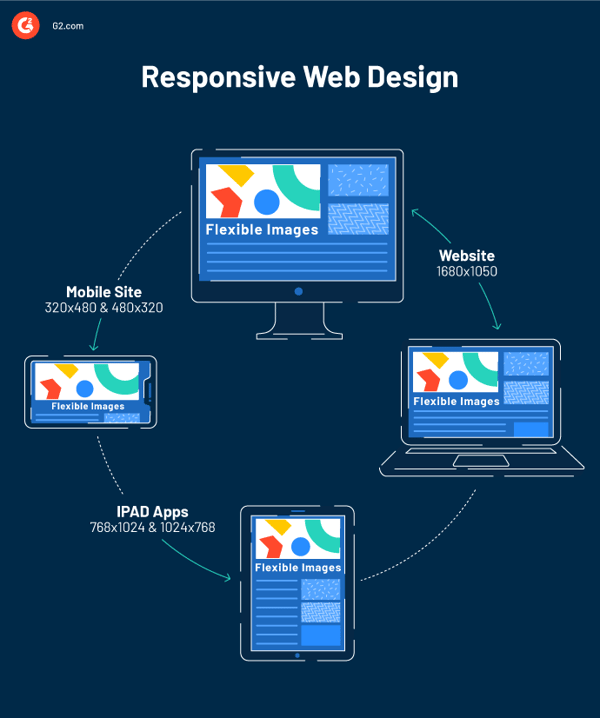January 23, 2024
.png?width=400&height=150&name=Copy%20of%20G2%20Image%20(1).png) by Shreya Mattoo / January 23, 2024
by Shreya Mattoo / January 23, 2024

Colors, fonts, and gradients can bring cash to your brand. Something I never thought I'd say.
Design has always been an intrinsic element of every core web development strategy. Be it a landing page, a blog, an advertising campaign, or a social media post, visuals precede text.
A business cannot function without an appealing website. Graphic designers and digital marketers spend hours ideating on the perfect picture story that visualizes their brand and strikes an instant chord with people.
The design part of web programming has been revolutionized with drag-and-drop features in web design software. These tools can help build images, vector graphics, charts, and animations through an easy-to-access global library.
Let’s learn how industries use web design templates with the most trending web design statistics for 2024.
Do you know that 94% of visitor impressions depend on web design? Further, research concludes that it takes about 50 milliseconds for a user to form an opinion about your website.
A steady and appealing web design increases dwell time and initiates the desire to act further down the purchase funnel. Besides scrolling through different content sections, the audience also searches for a visual that explains stuff in fewer words.
Basically, implementing web design is a doorway to optimizing your user interface, reducing the load on web crawlers, and reinstating your product value.
Let’s look at the first impression of web design statistics to illustrate the importance and prioritization of design over content.
of people prefer browsing beautiful and well-designed sites rather than basic ones, if pressed for time.
Source: Adobe
It’s hard to retain your audience’s attention on digital platforms. The uniqueness and parity of your web design and responsiveness of web elements would increase the average time on page on your website. This is known as first impression.
The following statistics collected as a recent survey drive prove the importance of web design to make a good first impression.
Based on the above stats, you can attest to the importance of web design for product marketing. From landing pages to blog writing to dedicated product descriptions, design elements need special attention.
When users look at the design, it should paint a picture of your product and brand. Further, it should align with their hand and eye movements. If you miss one button control or one scrollable response, they will go.
This brings us to responsive website design.
Knowing the latest web design statistics is great—but choosing the right tools to create a high-performing website is even better. Check out the best web design tools to turn data into stunning, user-friendly websites.
Web design comprises hypertext markup language (HTML) and cascading style sheet (CSS) elements. But that sets the tone of a static web design. To make a dynamic website, you need to code a responsive design. Responsive web design helps get traffic, signups, engagement and leads.
Responsive web design is a code declared within the HTML file of a web page. It can be a react.JS code or a simple PHP framework that powers form submissions, generates widget emails, and makes a website navigable.
Responsive websites are much more user-friendly and intuitive than static websites. Because not only does it enhance interactivity, but it retains users for a considerable amount of time.
Industries worldwide are encoding responsive website basics into their content management systems. Here is a sneak peek:
Responsive design elements aren’t as cutthroat as graphic design elements. They aren’t explicit but encoded using JavaScript.
The responsive design has the quality of interacting with the end user. For example, a banner image changes colors on user click, image adjustment as the user minimizes or maximizes the browser window, less load time, and the ability to start, stop, and pause an in-website video.
Let us look at the image adjustment options you can embed in your website to make it more responsive and increase user experience and, subsequently, page clicks.

Here are some industry-leading responsive web design statistics that would give you a greater insight into web development strategies across desktops and mobiles that brands follow:
When you feature catalogs, ads, copy, and visuals on a web page, chances are they appear different on browsing devices. The way your content shapes the end audience is crucial for successful marketing.
With increased numbers of US mobile users, brands want to scale website marketing strategies and mobile UX. It is difficult because the consumer has become more innovative in making decisions, but smart web design would give you a second purchase chance.
With this, let’s learn about mobile web design approaches to make websites more integrated, direct, and omnichannel.
The design of your mobile website may be more important than the look of your desktop website. Consumers check their devices an average of 150 times a day (BP Studios), so it’s vital that your site looks good and functions smoothly on a mobile phone.
With an increased population of mobile users, major industries are investing in their mobile websites. Towards the end of 2022, over 51.4% of traffic was generated from mobile in the United States.
With a poor mobile web design, brands won’t be able to target high-potential prospects or crack the brand marketing outreach campaign with higher numbers.
Let’s look at how mobile web design statistics have influenced the marketing industry today:
internet users claimed that slow page load speed interfered with their browsing experience.
Source: Forbes
Having a mobile counterpart for your desktop website is no alternative to building a successful go-to-market campaign. Setting web graphics, illustrations, media, and product features in a clear layout without overlaps makes up for a great mobile web design experience.
It’s great if your website is designed well, but it won’t matter if no one sees it. The following digital marketing statistics will help your business ensure that you get the online presence you need.
Here are some industry-leading web design statistics for digital marketing:
people in the world use social media, and the number is set to rise by 2027.
Source: Forbes
Different graphic design or content management systems today come with a pre-integrated repository of image media. Designing your website might impact your page speed or web design.
The US website design market has been growing yearly at 3.1% as of 2023. The need for graphic and product designers has peaked as brand owners realize their impact on the bottom line. To understand the market perception of web design, let us look at some all-time market statistics.
emails are sent and received daily, and every invested dollar earns $36 in email marketing.
Source: Forbes
When you reanalyze these stats, they seem unbelievable. Are purchase decisions so dependent on web design? The short answer is yes.
With an average duration of 5 or 6 seconds, web design is the fastest element to engage your audience. Investing your time revamping the contact information page, about us, and product page can account for high-quality lead generation.
Different brands in the e-commerce industry use different tools to build web design strategies. It is a prominent industry that uses graphic design to build a product’s selling proposition.
In the e-commerce sector, the channel contributing the most leads is online platforms. This is why most brands follow an integrated or omnichannel marketing strategy to convert first-timers or second-time buyers and build customer advocacies.
Let’s look at how e-commerce companies implement web design practices to make their website cleaner, more product-centric, and more action-provoking.
Now, you must have understood the importance of web design and investing a share of acquired revenue towards improving the same. Consumers are shapeshifting their needs and becoming aware of brand markets and value propositions.
Something different must be done to set your brand apart from the crowd. And design has taken center stage for brands.
Sources:
No matter how durable and value for money your product is, not creating a design strategy would make you lose millions of dollars in profit. The goal is not to mint profit but to establish yourself as a brand leader.
Keeping your design simple, crisp, and color-coded allows you to work your image as a people-first, product-led brand.
Learn about the 75+ latest branding statistics in 2024 to unlock your creative juices and build a brand the world can rely on.
Shreya Mattoo is a former Content Marketing Specialist at G2. She completed her Bachelor's in Computer Applications and is now pursuing Master's in Strategy and Leadership from Deakin University. She also holds an Advance Diploma in Business Analytics from NSDC. Her expertise lies in developing content around Augmented Reality, Virtual Reality, Artificial intelligence, Machine Learning, Peer Review Code, and Development Software. She wants to spread awareness for self-assist technologies in the tech community. When not working, she is either jamming out to rock music, reading crime fiction, or channeling her inner chef in the kitchen.
“The brand is a fire that drives customers.” - Bill Macaitis
.png) by Shreya Mattoo
by Shreya Mattoo
Banking on demand generation to keep your business afloat?
.png) by Shreya Mattoo
by Shreya Mattoo
In 2019, there were only 21 products in the AI Writing Assistant market.
 by Sydney Sloan
by Sydney Sloan
“The brand is a fire that drives customers.” - Bill Macaitis
.png) by Shreya Mattoo
by Shreya Mattoo
Banking on demand generation to keep your business afloat?
.png) by Shreya Mattoo
by Shreya Mattoo


